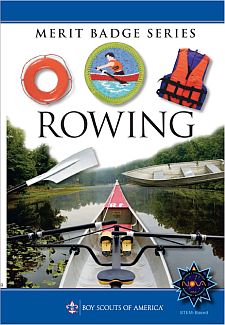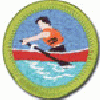- Show that you know first aid for and how to prevent
injuries or illnesses that could occur while rowing, including cold
and heat reactions, dehydration, contusions, lacerations,
and blisters.
2. Do the following:- Identify the conditions that must exist before
performing CPR on a person. Explain how such conditions are recognized.
Explain to your counselor the most likely hazards you may encounter while participating in rowing activities, including weather- and water-related hazards, and what you should do to anticipate, help prevent, mitigate, and respond to these hazards. - Demonstrate proper technique for performing
CPR using a training device approved by your counselor.
Review prevention, symptoms, and first-aid treatment for the following injuries or illnesses that can occur while rowing: blisters, hypothermia, heat related illnesses, dehydration, sunburn, sprains, and strains. - Review the BSA Safety Afloat policy. Explain to your counselor how this applies to rowing activities.
- Identify the conditions that must exist before
performing CPR on a person. Explain how such conditions are recognized.
- 3. Before doing the following requirements, successfully complete the BSA swimmer test. Jump feet first into water over your head in depth. Level off and swim 75 yards in a strong manner using one or more of the following strokes: sidestroke, breaststroke, trudgen, or crawl; then swim 25 yards using an easy, resting backstroke. The 100 yards must be completed in one swim without stops and must include at least one sharp turn. After completing the swim, rest by floating.
- 4. Review and discuss Safety Afloat and demonstrate
the proper fit and use of personal flotation devices (PFDs).
Review the characteristics of life jackets most appropriate for rowing and why one must always be worn while rowing. Then demonstrate how to select and fit a life jacket. - 5. Do ONE of the following:
- Alone or with a passenger, do the following
correctly in either a fixed-seat or sliding-seat
rowboat:
- Launch
- Row in a straight line for a quarter mile 100 yards. Stop, make a pivot turn, and return to the starting point.
- Backwater in a straight line for 50 25 yards. Make a turn under way and return to the starting point.
- Land and moor or rack your craft.
- Tie the following mooring knots: - clove hitch, roundturn with two half hitches, bowline, Wellman's knot, and mooring hitch.
- Participate as a rowing team member in a competitive rowing meet. The team may be sponsored by a school, club, or Scout unit. The meet must include competition between two or more teams with different sponsors. Complete at least 10 hours of team practice prior to the meet.
- Alone or with a passenger, do the following
correctly in either a fixed-seat or sliding-seat
rowboat:
- 6. Do ONE of the following:
- In a fixed-seat rowboat, come alongside a dock pier and help a passenger into the boat. Pull away from the dock pier, change positions with your passenger, and scull in good form demonstrate sculling over the stern for 10 yards, including at least one 180-degree turn or side. Resume your rowing position, return alongside the pier, and help your passenger out of the boat.
- In a sliding-seat rowboat, come alongside a pier and, with your buddy assisting you, get out onto the pier. Help your buddy into the boat. Reverse roles with your buddy and repeat the procedure.
- 7. Participate in a swamped boat drill, including righting and stabilizing the craft, reboarding in deep water, and making headway. Tell why you should stay with a swamped boat.
- 8. Alone in a rowboat, push off from the
shore or a dock pier.
Row 10 20 yards to
a swimmer. While giving instructions to the swimmer,
turn pivot the boat
so that the swimmer can hold onto the stern. Tow him to shore.
9. Show or explain the proper use of anchors for rowboats. - 10. Describe the following:
- Types of crafts craft used in commercial, competitive, and recreational rowing.
- Four common boat building materials. Give some positive and negative points of each.
- Types of oarlocks used in competitive, and recreational rowing.
- 11. Discuss the following:
- The advantage of feathering oars while rowing
- Precautions regarding strong winds and heavy waves, and boat-handling procedures in rough water and windstorms.
- How to properly fit out and maintain a boat in season, and how to prepare and store a boat for winter
- How to calculate the weight a boat can carry under normal conditions determine the proper length of oars
- The differences between fixed-seat and sliding-seat rowing
- The different meanings of the term sculling in fixed- and sliding-seat rowing
- The health benefits from rowing for exercise
BSA Advancement ID#:
98
Requirements last updated in:
2014
Pamphlet Publication Number:
35943
Pamphlet Stock (SKU) Number:
618657
Pamphlet Revision Date:
2014
| Worksheets for use in working on these requirements: | Format | |
|---|---|---|
| Word Format | PDF Format | |
Page updated on: November 18, 2021









